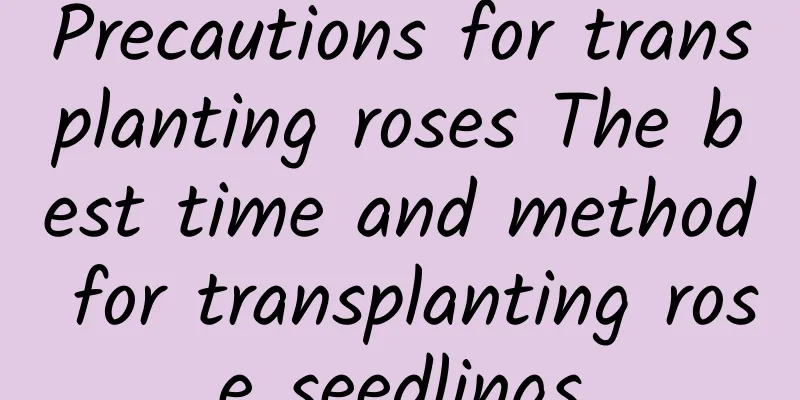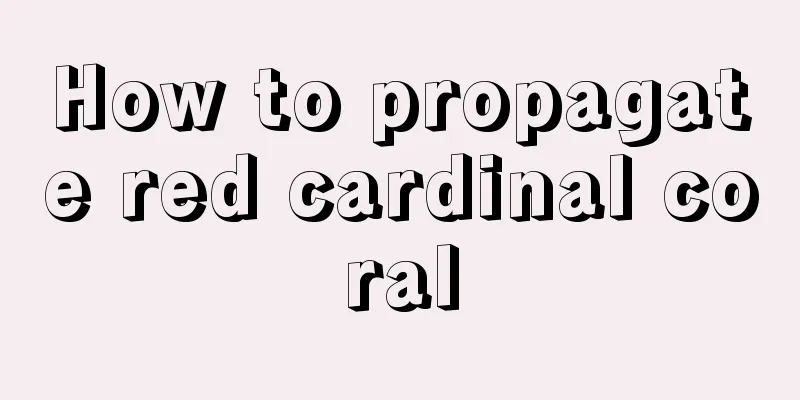Precautions for transplanting roses The best time and method for transplanting rose seedlings

|
Rose is a common plant that usually grows in a warm and humid environment. The best time for transplanting is in winter and spring, from November to around March of the following year. At this time, the climate is mild and the temperature is suitable. After transplanting, there is less damage to it and it is easy to survive. Points to note when transplanting roses1. Pruning Before transplanting roses, you need to check their root growth. If rotten or dead roots are found, cut them off in time. Also cut off all dead, rotten, diseased, old, overgrown, and weak branches and leaves to avoid them competing with normal branches and leaves for nutrients. 2. Transplantation Roses need loose, fertile and well-drained soil, mainly sandy soil, with appropriate amounts of perlite, humus and organic soil as the matrix. The soil and flower pots should be disinfected before use. The roots of transplanted roses need to carry some of the original soil with them, so that they can survive easily and adapt quickly when transplanted to the new soil. Rose transplanting management1. Water: After transplanting roses, maintenance and management are required. Water them thoroughly at one time. Do not water them too much or too little. Too much water will easily cause water accumulation, while too little water will cause the soil and roots to dry out. 2. Shading: Roses do not grow well after transplanting and need to be placed in a cool, well-ventilated place. In addition, the temperature is high in summer and the light intensity is high, so shading is necessary. This can effectively reduce the transpiration of the plants. Shading can last until the end of August. 3. Pests and diseases: Common diseases of roses in summer include powdery mildew and black spot. You can spray carbendazim once half a month after transplanting for prevention and control, and stop spraying in mid-September. Common pests of roses include scale insects, aphids, red spiders, etc. When the number is small, remove them manually. When the number is large, spray omethoate emulsifiable concentrate and dicofol emulsifiable concentrate for prevention and control. |
>>: Pitaya seedling cuttings rapid rooting method cuttings propagation and seedling raising method
Recommend
What to do if Phalaenopsis orchid leaves fall off
one. reason 1. Too much water. Although the aeria...
Grape planting methods and management techniques
As a fruit with significant economic benefits and...
Environmental conditions and characteristics of chestnut tree growth
Chestnut tree growth environment conditions and r...
Can pure milk be used to pour over meat?
Can pure milk be used to pour over meat? You cann...
Wisteria pruning
1. Summer pruning After the wisteria has finished...
When does the cockscomb erythrina bloom?
Flowering period Its flowering period is from Apr...
The aroma of 6 plants can actually prevent and cure diseases
Orchid fragrance It can relieve lung heat and phl...
How to water rosewood bonsai
Watering tips for rosewood bonsai When red sandal...
When is the best time to sow mid-season rice in Hubei?
Suitable time for sowing mid-season rice in Hubei...
When to transplant onions
Onion is one of the main grown vegetables in Chin...
How to ferment a small amount of sheep manure at home (how to naturally ferment sheep manure as fertilizer)
Sheep manure is used as fertilizer for growing fl...
When and how to plant Artemisia selengensis
1. Planting time Planting wood chrysanthemum can ...
How to make baby's breath bloom and how to save seeds
1. How to make the pot explode 1. Pinching: If yo...
How often should you water your pineapple?
How often should you water your pineapple? Genera...
How to propagate fuchsia by cuttings
1. Cutting time When taking cuttings, you can do ...









